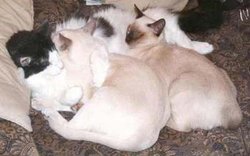Siamese (cat)
|
|
| Siamese |
|---|
| Country of origin |
| Thailand |
| Breed standards (external links) |
| CFA (http://www.cfainc.org/breeds/standards/siamese.html), ACFA (http://www.acfacats.com/siamese_standard.htm), TICA (http://www.tica.org/sibrdgrpstd03.pdf), CCA (http://cca-afc.com/standardsSiamese.html), ACF (http://www.acf.asn.au/Standards/Siamese.htm), FIFe |
The Siamese is one of the first distinctly recognised breeds of Oriental cat. The exact origins of the breed are unknown, but it is believed to be from South-East Asia, and may be descended from the sacred temple cats of Siam (hence their name). The breed was first seen outside their Asian home in 1884, when the British Counsul-General in Bangkok, Mr Owen Gould, brought a pair of the cats back to Britain for his sister, Mrs Veley (who went on to be co-founder of the Siamese Cat Club in 1901). The cats were shown at the Crystal Palace in 1885, and the following year another pair (with kittens) were imported by a Mrs. Vyvyan and her sister. A small number of cats were brought in over the next few years, and together these formed the base breeding pool for entire breed in Britain.
Traditionalsiameses.jpg
As a result of thousands of generations of selective breeding and the pressures of competition there are now actually two subbreeds of Siamese - the modern show Siamese, and the traditional or 'appleheaded' Siamese. Modern show Siamese have been bred to be extremely elongated, with bodies slender to the point of emaciation, and a Y-shaped head with an extremely long muzzle and extra-large 'batwing' ears. The traditional Siamese are much sturdier, with a round head and ears more in proportion to their size. Siamese cats often have a kink in their tails, because the original breeders saw that as a unique feature of the breed. In recent years the kinked tail has become a "flaw" and breeders have largely eradicated it from the Show Siamese. Both breeds of Siamese have almond-shaped eyes and like all Oriental cats they are extremely talkative and demanding of attention. They often will engage themselves in crazy antics to get the attention of their people, and often attach themselves to one human in a household. As they are wired for sound, they can meow loud enough to compete with fire and rescue equipment.
All Siamese have a creamy base coat with coloured "points" on their muzzles, ears, paws and lower legs, and tails. The darker Siamese have a darkening of their back and hindquarters as well. Originally Siamese were all chocolate pointed, but now they have been bred in all of the standard cat colours including red, lilac, blue, chocolate, tabby and torty or tortoise-shell. These coloured Siamese are generally known as colourpoints but in all other respects they are the same as the traditional brown, chocolate or black Siamese cats.
The coloration of the coat is determined by an enzyme that is heat-sensitive. All Siamese kittens, although pure cream or white at birth, develop visible points in the first few months of life in colder parts of their body. By the time the kitten is four weeks old the points should be clearly distinguishable enough to recognise which colour they will be.
Many Siamese are cross-eyed to compensate for the abnormal uncrossed wiring of the optic chiasm, which is produced by the same albino allele that produces coloured points.
Recent Siamese cats have been named 'Serengeti' when they are crossed with Bengal cats. The Serengeti often is almost indistinguishable from a normal Siamese.
See also
External links
- Siamese Cat History (http://www.meezer.com/siamhist.html)



